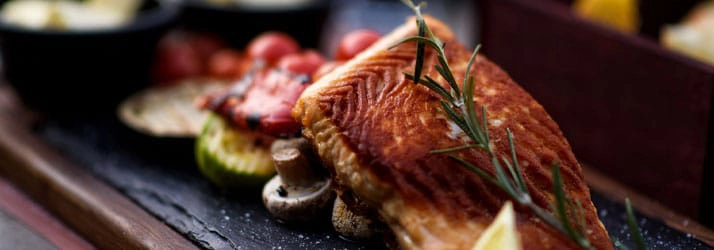For this week's Q&A Tuesday in Lafayette LA, we're wondering what the difference is between farmed fish and wild-caugt fish… Should we choose one over the ohther? And why?

While it may seem like a modern invention, "aquaculture," has been around for ages - man has been "farming" fish in net enclosures, ponds, vats, urns and even woven baskets for thousands of years. More recently though, say within the last few decades, worldwide demand has exploded and farming fish has grown just as rapidly, evolving into a multi-billion dollar industry. For the simple fact that by farming fish, you can produce more fish quicker, faster, larger and cheaper to meet the insatiable demand for what once seemed a limitless and inexpensive source of protein and good fat.
Not surprisingly, the extraordinary growth of the fish farm business has brought with it a number of industrial farming problems. While there are some fish farmers producing eco-friendly and healthy fish, they are the exception, not the rule, so unless you're able to purchase fish from those types of suppliers (usually smaller-scale, artisanal or boutique-style fish farms), pass on the farmed-fish and here are five simple reasons why it's a struggle to stay healthy in Lafayette LA:
1) There's no such thing as a free-range, farmed fish
In fact, it's quite the opposite, with fish farm enclosures packing the creatures in, leaving very little to no room for the fish to swim freely or to engage in their normal behavioral patterns. The result? Stressed fish, who like us, tend to get sick more easily when their defenses are down. With their immune systems compromised, the fish become more prone to illness, parasitic infections and diseases, which then can spread quickly through their over-populated small tanks.
2) Farmed fish are drugged
How do we get sick fish well? To do this, farmed fish are fed antibiotics, antifungals and/or pesticides - which means so are you, with every piece of tilapia (the nation's most common factory farmed type of fish) you eat. Gross, right? As if that weren't enough, farmed fish are often injected with booster shots of sex hormones. I read recently that captive fish populations tend to produce fewer offspring, so fish farms often enhance Mother Nature with fertility treatments (i.e., hormone shots, special feed, etc.) to stimulate offspring production and pump up the volume of fish being produced. Are your wheels turning yet? Has it crossed your mind as to what those fish hormones could be doing once inside your own body? Is it worth the risk to do an experiment? You decide.
3) Their diet is disgusting
As is the case with industrially farmed, land-based livestock, top quality, 5-star feed isn't on the menu, so what does the average farmed fish eat? Mostly fishmeal. Fishmeal is made up mostly of smaller fish mixed with soybeans, grains and corn (all ingredients which are unquestionable genetically modified). The larger issue, however, is that in order to make all that fishmeal, a tremendous amount of smaller fish are fished out of the sea - anywhere from 3-to-6 pounds of small fish are needed to produce just one pound of farmed fish. In addition to being an enormously wasteful process, it also leaves less food available for wild fish to feed on, which contributes to their population declines. Oh, and let's not forget to mention that in between meals, farmed fish snack on the carcasses of deceased fish floating in or lying at the bottom of their tanks.
4) If you're looking for nutrition, farmed fish falls short
Even if you could overlook the drugs, hormone shots and less-than-optimal diet, farmed fish still comes up short in terms of nutrition, one of the reasons so many of us turned to fish in the first place. Compared to wild fish, farmed versions have less protein, twice as much Omega-6 fatty acid (the evil step-sister to Omega-3 which causes inflammation) and fewer nutrients overall. In short, wild is better.
5) Industrial fish farms pollute their surroundings
Numerous studies report that water quality suffers in areas where fish farms operate, creating something akin to the aquatic version of agricultural run-off. Decaying fishmeal, diseased and dying fish and their waste products combine to create conditions that enable bacteria to flourish, polluting not only the fish farm waters but seeping into and damaging neighboring wild fish habitats, marshes and wetlands either by accident, carelessness or poor fish farming methods. Isn't all this damage and pollution is too high an ecological price to pay for farmed fish? You decide.
So, what the heck am I going to serve at this Friday's fish-fry?
The answer is wild-caught fish. To help you make the best possible choices, when buying fish at the market or dining out, ask questions and find out where your fish is sourced, and if it's fished sustainably. Before you buy, check your choices with against a printable list of eco-friendly seafood recommendations from www.Seafoodwatch.org. Or skip serving fish all together and try…
Spicy Cauliflower Bowl
- 1 head cauliflower, separated into small florets
- 2 Tbsp. olive oil
- 1 tsp. Slap Ya Mama
- 2 tsp. Bragg's Nutritional Yeast (optional)
- Salt and freshly ground pepper
- 1 cup quinoa, rinsed and drained (or brown rice)
- 2 large cloves garlic with skins on (or 4 small cloves)
- 1 Tbsp. lemon zest
- 3 Tbsp. golden raisins
- 3 Tbsp. toasted, sliced almonds
- Handful baby kale, chopped
- Preheat oven to 425 F. Line a baking sheet with parchment paper.
- In a bowl, combine spices, salt and pepper and whisk together with olive oil. Toss broken up cauliflower into the bowl and evenly coat them with oil-spice mixture.
- Spread on baking sheet and add garlic cloves. Bake for 35-40 minutes, stirring every 15 minutes to get the cauliflower evenly browned.
- Bring water to a boil in saucepan, then reduce heat and add quinoa and cook according to package directions.
- Remove cauliflower from oven. Remove garlic cloves and let cool. Once cooled, squeeze roasted garlic from skins and mash with a fork.
- In a large bowl, fold together cauliflower, quinoa, garlic, lemon zest, raisins and roasted almonds. Serve in individual bowls and garnish with baby kale. Tastes great either served warm or room temperature!
By Francesca Marino D.C.
OFFICE HOURS
Monday
8:30am - 5:30pm
Tuesday
8:30am - 5:30pm
Wednesday
Closed
Thursday
8:30am - 5:30pm
Friday
7:30am - 11:30am
Saturday & Sunday
Closed
Open for Massage & Treatment
During Business Hours
Modern Chiropractic
318 Bertrand Dr #101
Lafayette, LA 70506



